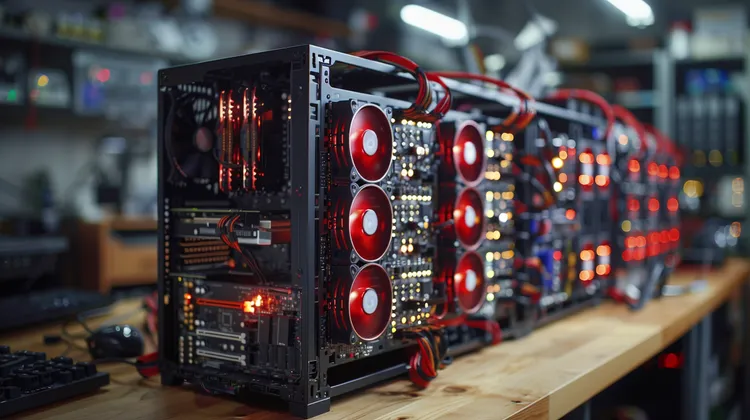Cryptocurrency mining has evolved from a hobbyist activity into a sophisticated operation involving substantial computing power and technical knowledge. For beginners interested in joining the mining community, it’s crucial to understand the fundamentals of blockchain technology, the requirements for mining, and the potential risks and rewards. This guide will provide you with the necessary steps to start mining cryptocurrency.
**1. Understanding Cryptocurrency Mining**
Before you dive into cryptocurrency mining, it’s essential to grasp what mining entails. Mining is the process of validating and adding transaction records to a blockchain’s public ledger, known as a blockchain. Miners use their computational power to solve complex mathematical problems, and in return, they are rewarded with newly created coins and transaction fees from the verified transactions.
**2. Choosing the Right Cryptocurrency**
Many cryptocurrencies exist, each with its own mining processes and profitability. Bitcoin is the most well-known, but mining it can be quite challenging because of the high competition and significant upfront investment required. Alternatively, there are other altcoins like Ethereum, Litecoin, and Monero, which might be more accessible to beginners. Do your research to find a cryptocurrency that aligns with your goals and resources.
**3. Mining Methods: Solo vs. Pool vs. Cloud Mining**
There are several methods to mine cryptocurrencies. Solo mining entails validating transactions on your own, which may require substantial investment in hardware but could lead to larger rewards since you don’t share them. Pool mining combines your resources with other miners to increase the chances of successfully mining a block, sharing profits among participants. Cloud mining involves renting mining power from a third-party provider, eliminating the need for hardware investment but often at the expense of higher fees and lower profits.
**4. Assessing Profitability**
Before investing in mining equipment or cloud mining contracts, it is vital to assess the potential profitability. There are online calculators where you can input the hash rate, power consumption, electricity costs, and current cryptocurrency prices to estimate your returns. Remember that profitability can be highly volatile, depending on market conditions and mining difficulty.
**5. Acquiring Mining Hardware**
If you choose to mine on your hardware, you will need to purchase specialized mining rigs like ASICs (Application-Specific Integrated Circuits) for Bitcoin mining or powerful GPUs (Graphics Processing Units) for altcoin mining. Ensure that your selected hardware is compatible with the cryptocurrency you have chosen to mine.
**6. Setting Up the Hardware**
Once you have your hardware, set it up following the manufacturer’s guidelines. Location is vital as mining hardware generates significant heat and noise. Ensure ample cooling and a noise-tolerant environment. Some miners opt for dedicated mining farms, while others may use spare space at home.
**7. Choosing Mining Software**
After setting up the hardware, you’ll need mining software to connect your equipment to the blockchain or mining pool. There are many free and paid mining applications available, each supporting different cryptocurrencies and hardware types. Choose one that is compatible with your hardware and the cryptocurrency you want to mine.
**8. Joining a Mining Pool**
If you’ve chosen to join a mining pool, you’ll need to sign up and follow their instructions on configuring your mining software. Pools typically charge a fee, usually 1-2% of your earnings, which goes towards the maintenance of the pool’s services.
**9. Setting Up a Cryptocurrency Wallet**
You will need a cryptocurrency wallet to receive and store your mining rewards. There are many types of wallets, including software, mobile, hardware, and paper wallets. Security is a critical factor when choosing a wallet, so consider using hardware or paper wallets for large sums as they are less susceptible to online hacking.
**10. Starting to Mine**
Once your hardware, software, and wallet are ready, you can start mining. Monitor your operation closely in the first few days to ensure that everything runs smoothly. Expect to spend time fine-tuning your setup to maximize efficiency and profitability.
**11. Keeping Track of Earnings and Expenses**
Mining can be a business, so maintaining accurate records of your earnings and expenses is essential. This will not only help you understand the financial health of your mining operation but also prepare you for tax implications.
**12. Staying Informed and Adapting**
The cryptocurrency market is dynamic, and mining is increasingly competitive. You will need to continually educate yourself on the latest trends and adjust your strategies accordingly. Join mining forums, follow cryptocurrency news, and participate in miner communities to keep up with changes.
**13. Be Wary of the Environmental Impact**
Cryptocurrency mining is energy-intensive, and its environmental impact has been a growing concern. Consider the source of your electricity and explore sustainable options like solar or wind energy to power your mining operation.
**14. Learn About Risks**
Be aware of the risks involved in cryptocurrency mining. The volatility of cryptocurrency prices, potential changes in mining technology, and evolving regulatory environments can substantially impact profitability.
By following these steps and continuing to educate yourself on the rapidly evolving landscape of cryptocurrency mining, you can begin your journey as a crypto miner. Remember that smart investments, careful planning, and a mindful approach toward the environmental impact can make your mining venture not just profitable but also sustainable in the long run.




This is a stellar roadmap for us crypto rookies! Can’t wait to start tinkering with my mining setup.